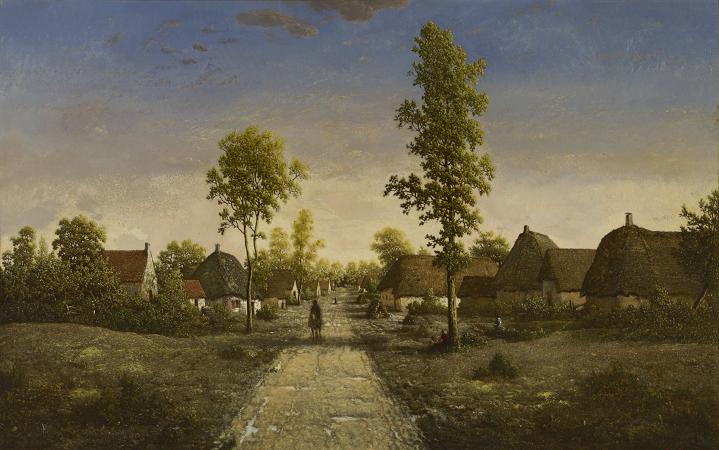Jean-Francois Millet (1814 - 1875). Jean-François Millet was a French painter and one of the founders of the Barbizon school in rural France. Millet is noted for his scenes of peasant farmers; he can be categorized as part of the Realism art movement. Millet was the first child of Jean-Louis-Nicolas and Aimée-Henriette-Adélaide Henry Millet, members of the farming community in the village of Gruchy, in Gréville-Hague, close to the coast. Under the guidance of two village priests, one of them was vicar Jean Lebrisseux, Millet acquired a knowledge of Latin and modern authors. But soon he had to help his father with the farm-work; because Millet was the eldest of the sons. So all the farmer's work was familiar to him: to mow, make hay, bind the sheaves, thresh, winnow, spread manure, plow, sow, etc. All these motifs would return in his later art. This stopped when he was 18 and sent by his father to Cherbourg in 1833, to study with a portrait painter named Paul Dumouchel. By 1835 he was studying full-time with Lucien-Théophile Langlois, a pupil of Baron Gros, in Cherbourg. A stipend provided by Langlois and others enabled Millet to move to Paris in 1837, where he studied at the École des Beaux-Arts with Paul Delaroche. In 1839 his scholarship was terminated, and his first submission to the Salon was rejected. After his first painting, a portrait, was accepted at the Salon of 1840, Millet returned to Cherbourg to begin a career as a portrait painter. However, the following year he married Pauline-Virginie Ono, and they moved to Paris. After rejections at the Salon of 1843 and Pauline's death by consumption, Millet returned again to Cherbourg. In 1845 Millet moved to Le Havre with Catherine Lemaire, whom he would marry in a civil ceremony in 1853; they would have nine children and remain together for the rest of Millet's life. In Le Havre he painted portraits and small genre pieces for several months, before moving back to Paris. It was in Paris in the middle 1840s that Millet befriended Constant Troyon, Narcisse Diaz, Charles Jacque, and Théodore Rousseau, artists who, like Millet, would become associated with the Barbizon school; Honoré Daumier, whose figure draftsmanship would influence Millet's subsequent rendering of peasant subjects; and Alfred Sensier, a government bureaucrat who would become a lifelong supporter and eventually the artist's biographer. In 1847 his first Salon success came with the exhibition of a painting Oedipus Taken down from the Tree, and in 1848 his Winnower was bought by the government. The Captivity of the Jews in Babylon, Millet's most ambitious work at the time, was unveiled at the Salon of 1848, but was scorned by art critics and the public alike. The painting eventually disappeared shortly thereafter, leading historians to believe that Millet destroyed it. In 1984, scientists at the Museum of Fine Arts in Boston x-rayed Millet's 1870 painting The Young Shepherdess looking for minor changes, and discovered that it was painted over Captivity. It is now believed that Millet reused the canvas when materials were in short supply during the Franco-Prussian War. In 1849, Millet painted Harvesters, a commission for the state. In the Salon of that year, he exhibited Shepherdess Sitting at the Edge of the Forest, a very small oil painting which marked a turning away from previous idealized pastoral subjects, in favor of a more realistic and personal approach. In June of that year, he settled in Barbizon with Catherine and their children. In 1850 Millet entered into an arrangement with Sensier, who provided the artist with materials and money in return for drawings and paintings, while Millet simultaneously was free to continue selling work to other buyers as well. At that year's Salon, he exhibited Haymakers and The Sower, his first major masterpiece and the earliest of the iconic trio of paintings that would include The Gleaners and The Angelus. From 1850 to 1853, Millet worked on Harvesters Resting, a painting he would consider his most important, and on which he worked the longest. Conceived to rival his heroes Michelangelo and Poussin, it was also the painting that marked his transition from the depiction of symbolic imagery of peasant life to that of contemporary social conditions. It was the only painting he ever dated, and was the first work to garner him official recognition, a second-class medal at the 1853 salon. This is one of the most well known of Millet's paintings, The Gleaners. While Millet was walking the fields around Barbizon, one theme returned to his pencil and brush for seven years, gleaning, the centuries-old right of poor women and children to remove the bits of grain left in the fields following the harvest.
more...














